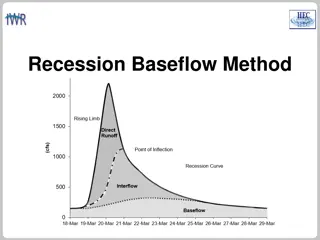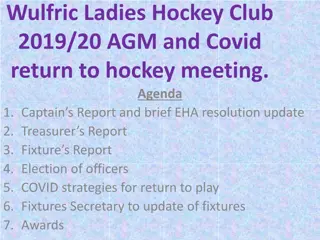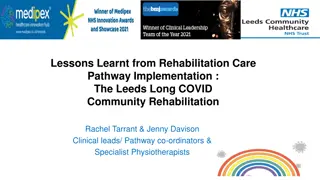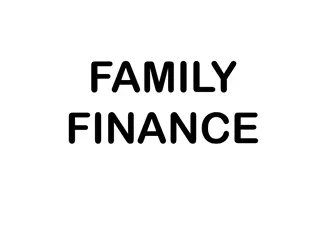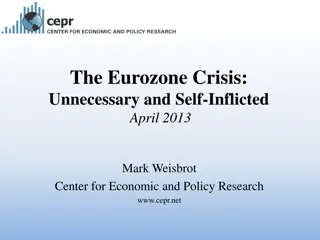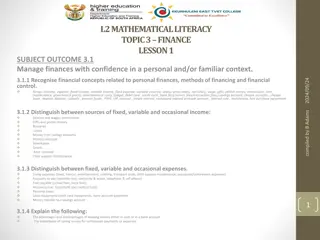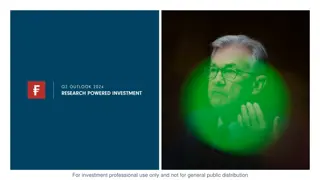Managing Finances During the COVID-19 Recession
Exploring the severe economic impact of the COVID-19 recession on local governments, jobs, and retail, with insights on budget shortfalls and strategies to address the crisis. The webinar provides tools for forecasting and understanding the implications of this unprecedented economic downturn.
Download Presentation

Please find below an Image/Link to download the presentation.
The content on the website is provided AS IS for your information and personal use only. It may not be sold, licensed, or shared on other websites without obtaining consent from the author.If you encounter any issues during the download, it is possible that the publisher has removed the file from their server.
You are allowed to download the files provided on this website for personal or commercial use, subject to the condition that they are used lawfully. All files are the property of their respective owners.
The content on the website is provided AS IS for your information and personal use only. It may not be sold, licensed, or shared on other websites without obtaining consent from the author.
E N D
Presentation Transcript
Budgeting During a Crisis: Responding to the COVID-19 Recession April 17, 2020
Objectives of Todays Webinar 1 2 3 4 Preview sample forecasting tool to help project the impact of the COVID- 19 downturn Offer initial projections about potential financial impacts of COVID-19 on cities Explore phases of response, from forecasting to cutbacks to policy solutions Share strategies for addressing this emergency 2
The COVID-19 Recession: Much of the Economy Immediately Shut Down About 95% of U.S. population, about 306 million people, are under stay-at- home orders Consequently, economic activity has been greatly decreased Local governments, especially cities, depend on economic activity for tax revenues 3
The COVID-19 Recession: Unemployment Spike, Retail Collapse Nearly 22 million new unemployment claims were filed in the past month, while retail sales plunged a record-breaking 8.7 percent. 4
The COVID-19 Recession: Swift, Severe Impact During the Great Recession, 8.7 million jobs were shed over two years; half the job loss in 2020 so far. The International Monetary Fund predicts the current downturn will be the worst since the Great Depression in the 1930s. 5
The COVID-19 Recession: Local Governments Hit Hard Nearly 9 in 10 city leaders say they expect major budget shortfalls according to a survey of 2,400 local leaders by National League of Cities and U.S. Conference of Mayors CARES Act is putting $2 trillion into economy, direct aid to cities under 500,000 is still unclear, but it appears to be about $170 per capita (California numbers) Local governments must submit certifications by April 17 https://forms.treasury.gov/caresact/stateandlocal 6
The COVID-19 Recession: Local Governments Hit Hard Source: National League of Cities survey 7
The COVID-19 Recession: Local Governments Hit Hard Source: National League of Cities survey 8
Step 1: Understand the next 6 to 18 months Forecast how revenues will be affected by the pandemic-induced economic downturn. Timing of the impact will depend on each jurisdiction s major revenue sources and elasticity of sources Develop a range of scenarios tied to assumptions about the downturn s severity. Each city is unique some will see major problems as early as this fall Determine how soon General Fund resources might be depleted. 9
Local Agency Revenue Impacts Vary by Source Property Tax Recreation and Fee Programs Income Tax Utility Users Tax, Franchise Payments Sales Tax, Hotel Tax, Property Transfer Tax Business License Tax 10
What Will This Recession Look Like? Need to forecast magnitude and duration of impact to be set by revenue source by fiscal year Losses are compared to a pre-recession forecast 11
Elements to Include in a Short-Term Forecast Agency-specific data Recent and budgeted (pre-recession) revenues and expenditures by category, fund balance No-recession forecast Recession forecast Allow for flexibility Dashboard of charts showing fund balance, annual shortfall, revenue loss, cash flow Different scenarios 12
Elements to Include in a Short-Term Forecast Magnitude and duration of losses, by source by fiscal year Pre-recession growth rates by revenue source Payroll growth by police/fire/other; set growth rates such as pension, O&M, debt, capital New local sales tax, budget cuts, budget increases Potential federal aid or cash flow loan Key assumptions 13
Sample Forecast Before the Covid-19 Recession Here is a city that is doing pretty well in the near-term, assuming no recession They are at or near their reserve goal until 2025, when rising pension costs will drive down their available fund balance Corrective actions will eventually be needed, even without a recession 14
Sample Forecast Define Scale & Timing of Revenue Loss Flexibility needed given range of potential impacts This particular model allows magnitude of loss to be defined by revenue source, by fiscal year Shows severe impact in first two years, declining impact over next four years Amounts Show Percent Revenue is Below the No-Recession Forecast 4 4 3 3 << Loss Option Phase-out >> SEVERE FY 19/20 0.00% -15.00% 0.00% 0.00% -25.00% -25.00% -10.00% 0.00% 0.00% -10.00% -20.00% -25.00% -25.00% -20.00% 0.00% -10.00% 0.00% SEVERE FY 20/21 0.00% -20.00% 0.00% -40.00% -50.00% -40.00% -5.00% 0.00% 0.00% -20.00% -30.00% -30.00% -30.00% -25.00% 0.00% -10.00% 0.00% HIGH FY 21/22 -12.00% -12.00% 0.00% -24.00% -24.00% -18.00% -3.00% 0.00% 0.00% -12.00% -18.00% -18.00% -18.00% -15.00% 0.00% -6.00% 0.00% LOSSES END FY 24/25 None Revenue Source Property Tax Sales & Use Tax/T&UT Utility Users Tax Business License Tax Transient Occupancy Tax Property Transfer Tax Franchise Payments All Other Taxes Intergovernmental Fines & Forfeitures Licenses & Permits Community Develop Fees Park & Recreation Fees Other Fees & Charges Interfund Charges Other Revenue Transfers In FY 22/23 -9.00% -9.00% 0.00% -18.00% -18.00% -13.50% -2.25% 0.00% 0.00% -9.00% -13.50% -13.50% -13.50% -11.25% 0.00% -4.50% 0.00% FY 23/24 -6.00% -6.00% 0.00% -12.00% -12.00% -9.00% -1.50% 0.00% 0.00% -6.00% -9.00% -9.00% -9.00% -7.50% 0.00% -3.00% 0.00% FY 24/25 -3.00% -3.00% 0.00% -6.00% -6.00% -4.50% -0.75% 0.00% 0.00% -3.00% -4.50% -4.50% -4.50% -3.75% 0.00% -1.50% 0.00% Numbers are amount below the pre-recession forecast in each year, not percent change over prior year; zero means no loss compared to a no-recession scenario 15
Sample Forecast Resulting Revenue Loss This particular scenario results in a $99M revenue loss over six years Loss highlighted in yellow Revenue loss is before any: Federal assistance Short- or medium-term borrowing to bridge cash flow shortfall Corrective budget actions to cut spending or increase revenues Sample City General Fund Revenue Gap (mil.) Expenditures Revenue w/o Recession Revenue w/ Recession Revenue Loss $260 $240 $220 $200 $180 $160 17/18 18/19 19/20 20/21 21/22 22/23 23/24 24/25 25/26 26/27 $99.2M Total Revenue Loss: before Fed aid/loan 16
Sample Forecast After the Covid-19 Recession With this magnitude of revenue loss, and no mitigating actions, city is in deficit by FY 20/21 Urgent action required, given time needed to craft and implement budget cuts or revenue increases 17
Sample Forecast Cash is King Examine your monthly cash flow for closer look at time available to your agency to enact budget strategies Under this scenario, the city is permanently in the red by May 2021 18
Sample Forecast Scenario Planning Before: Baseline Revenues and Expenditures Adjust pre-recession revenue growth rates Vary growth rates of key areas such as staffing levels, salaries, pension, health, O&M, debt, capital After: Incorporate Revenue Loss from COVID-19 Recession Vary severity of loss and recovery period, and continually adjust impacts as better information becomes available on local economic activity Mitigation: Model Impact of Corrective Measures Budget reductions, tax increase Federal assistance, borrowing 19
Sample Forecast Comparison to Great Recession Percentages are amount below revenue forecast without COVID-19 recession Percentages are amount below a revenue forecast that assumes the Great Recession did not happen Dust off old data, create a pre-Great Recession forecast, and compare to actuals for that period Then compare to what your scenarios show for COVID-19 recession This example shows a more severe initial loss under COVID-19, whereas Great Recession impact built up over several years, and the recovery took longer than this sample forecast assumes for COVID-19; this is only one potential outcome 20
There is No Single Right Answer Local economy and revenue sources vary among agencies Many moving parts, and outcomes you don t control Uncertainty is unavoidable, you inevitably will be wrong But difficult policy decisions need the best information available to support them Develop a forecast using reasonable estimates, and create a plan capable of responding to a range of potential outcomes 21
Step 2: Reduce Spending Reduce capital asset investments Defer some purchases Improve capital project management Reexamine maintenance and replacement standards Refinance debt 22
Step 2: Find New Resources Increase interfund charges where there is a case for it Reassess internal service fund and cost allocation formulas Redesignate general fund reserves Consider monetizing assets Implement new or revised fees where appropriate Consider short-term borrowing 23
Step 2: Reduce Materials or Contractor Costs Close facilities where social distancing isn t possible Eliminate lower-value or no-use programs Review contractor costs and renegotiate if possible Rethink subsidies, as painful as this might be 24
Step 3: Communicate and Engage Once managers know the extent of the problem, they must help elected officials, employees and community members understand the challenges and gather input on possible solutions. Solution scenarios can be run as they are developed 25
Step 3: Communicate and Engage Use videoconferencing, Facebook Live, other technology to get the word out and gather feedback Technology allows new voices to participate Solution scenarios can be run as they are developed Use social media and the city s website to provide updates 26
Step 4: Support Decision-Making Understanding impacts to revenues and possible scenarios is key to good decision- making Solutions supported by governing body form the basis of action Solution scenarios can be run as they are developed Clear graphics help communicate a message, especially in online meetings 27
Conclusion Our financial world is uncertain, and the 2020-21 budget picture is unclear. Cities are starting now to plan ahead for a possible 6- to 18-month recession unlike any other. The four steps of the COVID-19 Recession Response form the foundation of a local government s plan to address the crisis. Communication with the community and governing body is key to finding solutions. 28
Andy Belknap, Senior Vice President Thank You! Nancy Hetrick, Vice President nhetrick@managementpartners.com (408) 674-3369




